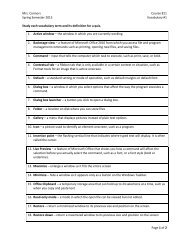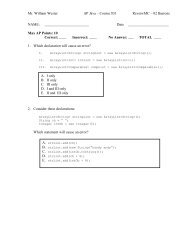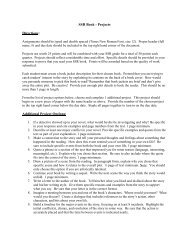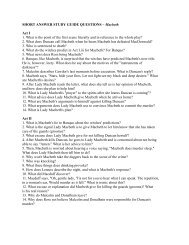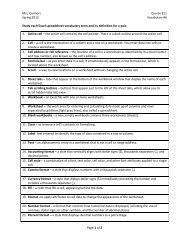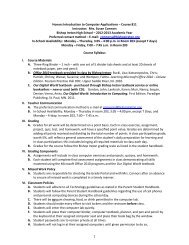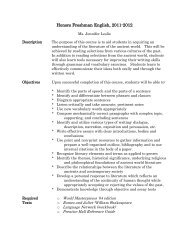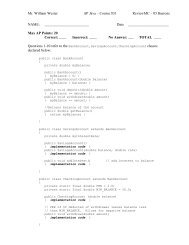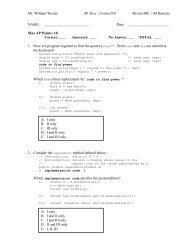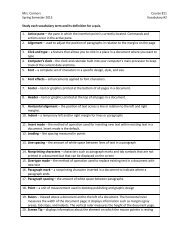Stability Across Cohorts in Divorce Risk Factors - Bishop Ireton High ...
Stability Across Cohorts in Divorce Risk Factors - Bishop Ireton High ...
Stability Across Cohorts in Divorce Risk Factors - Bishop Ireton High ...
Create successful ePaper yourself
Turn your PDF publications into a flip-book with our unique Google optimized e-Paper software.
336 Demography, Volume 39-Number 2, May 2002<br />
DESCRIPTIVE RESULTS<br />
Age at marriage for both husbands and wives was coded <strong>in</strong> years; education was coded <strong>in</strong><br />
years of completed school<strong>in</strong>g; premarital birth was coded 1 for women who entered the<br />
first marriage with a birth, 0 otherwise; premarital conception was coded 1 for women<br />
who gave birth to a child with<strong>in</strong> the first seven months of marriage, 0 otherwise; wife<br />
older was coded 1 when the woman was two or more years older than her husband, 0<br />
otherwise; husband older was coded 1 when the husband was five or more years older<br />
than his wife, 0 otherwise; wife has more education was coded 1 if the wife had at least a<br />
high school degree and at least two years of school<strong>in</strong>g more than her husband, 0 otherwise;<br />
parents divorced was coded 1 if the woman was not liv<strong>in</strong>g with both biological<br />
parents at age 14 because of divorce, 0 otherwise; Catholic was coded 1 for women who<br />
reported be<strong>in</strong>g Catholic, 0 otherwise; black was coded 1 for women who reported they<br />
are black, 0 otherwise; and other race was coded 1 for women who did not report their<br />
race as either white or black.<br />
Each of these predictor variables has received considerable attention <strong>in</strong> the literature<br />
(see the reviews <strong>in</strong> DaVanzo and Rahman 1993; Faust and McKibben 1999; Teachman,<br />
Tedrow, and Crowder 2000; White 1990), and I did not develop separate rationales for<br />
<strong>in</strong>clud<strong>in</strong>g them <strong>in</strong> the analysis. In general, it has been found that the risk of divorce decl<strong>in</strong>es<br />
with <strong>in</strong>creases <strong>in</strong> age at marriage and education. <strong>Divorce</strong> is also less likely among<br />
Catholics and whites, <strong>in</strong> age- and educationally homogeneous marriages, and <strong>in</strong> marriages<br />
not preceded by a birth or conception or a parental divorce.<br />
Although the sample is large, the number of divorces that occurred for women who<br />
were married <strong>in</strong> a given year was small. Thus, the number of divorces accord<strong>in</strong>g to a<br />
s<strong>in</strong>gle year of marriage showed substantial random fluctuation. To alleviate this problem,<br />
I grouped marriages <strong>in</strong>to five-year cohorts: 1950–1954, 1955–1959, 1960–1964, 1965–<br />
1969, 1970–1974, 1975–1979, and 1980–1984. I calculated a cont<strong>in</strong>uous measure for year<br />
of marriage by cod<strong>in</strong>g 1 for marriages formed <strong>in</strong> 1950–1954, 2 for marriages formed <strong>in</strong><br />
1955–1959, and so forth to 7 for marriages formed <strong>in</strong> 1980–1984. This is the measure of<br />
year of marriage used <strong>in</strong> all the models.<br />
All results are shown us<strong>in</strong>g unweighted data. I do not provide descriptive statistics<br />
based on weighted data because I know a priori that the distributions of the predictor<br />
variables by marriage cohort are not nationally representative of each cohort. The purpose<br />
of this article is not to document accurately changes across marriage cohorts <strong>in</strong> their<br />
composition but, rather, to ascerta<strong>in</strong> whether the effects of important predictor variables<br />
change across time. As I describe later, I conducted a number of sensitivity tests to ascerta<strong>in</strong><br />
the robustness of my results. F<strong>in</strong>ally, results from the Cox proportional hazards models<br />
are shown as a function of the unweighted data to preserve the appropriate calculation<br />
of standard errors. 4<br />
Descriptive statistics for the sample are shown <strong>in</strong> Table 1. Although the results are<br />
biased by the fact that age at marriage is truncated <strong>in</strong> early marriage cohorts, they are<br />
consistent with previous research. In particular, age at marriage and education have<br />
shifted upward for both husbands and wives. In addition, more marriages are preceded<br />
by a premarital birth, and more women come from families that are disrupted by divorce.<br />
There is also some <strong>in</strong>dication that heterogeneity <strong>in</strong> marriage has shifted toward more<br />
women be<strong>in</strong>g older and hav<strong>in</strong>g more education than their husbands. Variations <strong>in</strong> racial<br />
composition and religion are more difficult to <strong>in</strong>terpret but likely reflect the overall retreat<br />
from marriage by blacks and the rapid <strong>in</strong>crease of the Hispanic population <strong>in</strong> the<br />
United States. As a result, blacks constitute a smaller share of all marriages, and there<br />
4. In results not shown here, the coefficients estimated from weighted data were not substantially different<br />
from those estimated from unweighted data.




